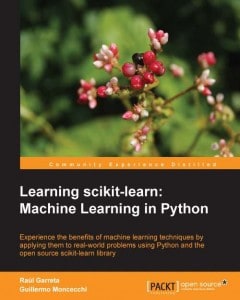The people at Packt Publishing recently sent me an ebook copy of Raúl Garreta and Guillermo Moncecchi’s book, Learning scikit-learn: Machine Learning in Python to review. Machine learning isn’t a topic I’m very familiar with, but I gave the book a shot as it sounded interesting. I’ll start off with my quick review for those of you with little time:
Quick Review
- Why I picked it up: This book was a review copy, but I’m actually interested in just about any Python programming book
- Why I finished it: The book is well written and while I don’t understand a lot of it, the gist of the text was interesting…and I skimmed a lot.
- I’d give it to: Someone who uses Python for scientific purposes or machine learning
If you found that intriguing, then feel free to read the full review!
Book Formats
This book can be bought in paperback, PDF, epub and Kindle formats
Full Review
Packt Publishing has a concept that they call “Instant” books. These books tend to be around 100 pages long. While this book isn’t labeled as “Instant”, I think it fits the category as it only runs 118 pages across 4 chapters. This book is for advanced users. In fact, I would say it’s for people with advanced mathematics or other science degrees. Frankly, while the contents are interesting, I barely grasped the concepts. So this is going to be a pretty light review.
First of all, you will need scikit-learn and NumPy. I am not sure is SciPy is also required or not. The first chapter is about installing scikit-learn and is also a “gentle introduction” to machine learning. Chapter 2 covers a topic called Supervised Learning. In this chapter, you learn about image recognition, Naive Bayes, the Titanic hypothesis, decision trees, random forests and vector machines. I enjoyed the Bayes explanation and learning about image recognition was pretty cool.
Chapter 3 goes into the world of Unsupervised Learning, a topic I found rather confusing. The authors wrote about Principal Component Analysis, clustering with k-means and various other clustering methods. I didn’t really understand this chapter. Chapter 4 is about the advanced features of scikit-learn. It covers such items as feature extraction and selection, model selection, and grid search.
The authors seem quite knowledgeable in their field and the book is well written. I didn’t really notice any major issues with their prose. The code examples looked clean, but I didn’t test them. I would certainly recommend this book to programmers needing to learn how to use Python for machine learning. .
 |
Learning scikit-learn: Machine Learning in Pythonby Raúl Garreta and Guillermo Moncecchi |
Other Book Reviews
- Instant Flask Web Development by Ron DuPlain
- Real Python by Fletcher Heisler
- Treading on Python Volume 2: Intermediate Python by Matt Harrison
- Learn Python Quickly by John Rowland

Pingback: eBook Review: Python High Performance Programming | Hello Linux